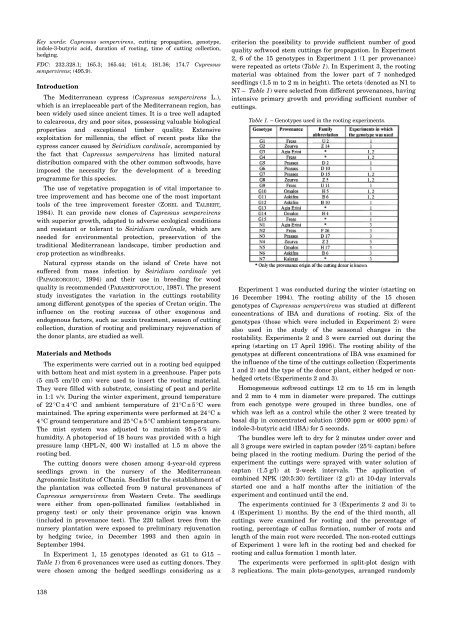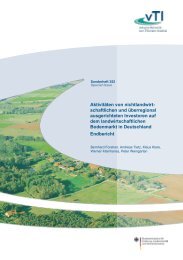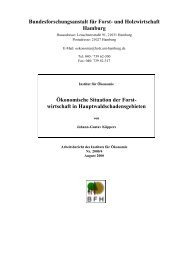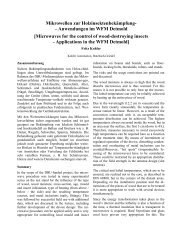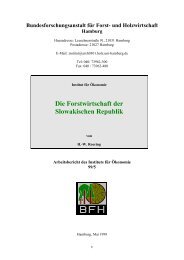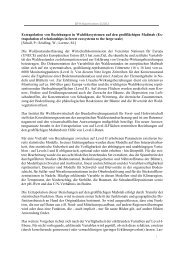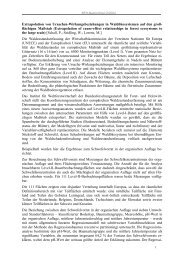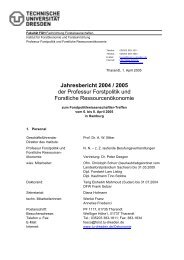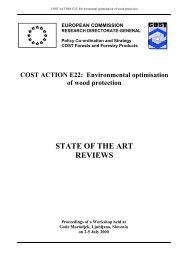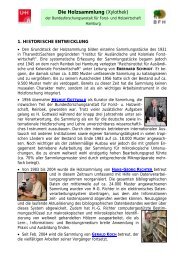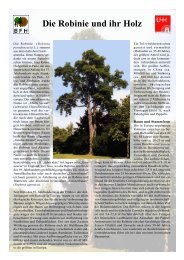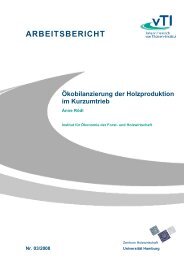Vegetative Propagation of Cupressus sempervirens
Vegetative Propagation of Cupressus sempervirens
Vegetative Propagation of Cupressus sempervirens
You also want an ePaper? Increase the reach of your titles
YUMPU automatically turns print PDFs into web optimized ePapers that Google loves.
Key words: <strong>Cupressus</strong> <strong>sempervirens</strong>, cutting propagation, genotype,<br />
indole-3-butyric acid, duration <strong>of</strong> rooting, time <strong>of</strong> cutting collection,<br />
hedging.<br />
FDC: 232.328.1; 165.3; 165.44; 161.4; 181.36; 174.7 <strong>Cupressus</strong><br />
<strong>sempervirens</strong>; (495.9).<br />
Introduction<br />
The Mediterranean cypress (<strong>Cupressus</strong> <strong>sempervirens</strong> L.),<br />
which is an irreplaceable part <strong>of</strong> the Mediterranean region, has<br />
been widely used since ancient times. It is a tree well adapted<br />
to calcareous, dry and poor sites, possessing valuable biological<br />
properties and exceptional timber quality. Extensive<br />
exploitation for millennia, the effect <strong>of</strong> recent pests like the<br />
cypress cancer caused by Seiridium cardinale, accompanied by<br />
the fact that <strong>Cupressus</strong> <strong>sempervirens</strong> has limited natural<br />
distribution compared with the other common s<strong>of</strong>twoods, have<br />
imposed the necessity for the development <strong>of</strong> a breeding<br />
programme for this species.<br />
The use <strong>of</strong> vegetative propagation is <strong>of</strong> vital importance to<br />
tree improvement and has become one <strong>of</strong> the most important<br />
tools <strong>of</strong> the tree improvement forester (ZOBEL and TALBERT,<br />
1984). It can provide new clones <strong>of</strong> <strong>Cupressus</strong> <strong>sempervirens</strong><br />
with superior growth, adapted to adverse ecological conditions<br />
and resistant or tolerant to Seiridium cardinale, which are<br />
needed for environmental protection, preservation <strong>of</strong> the<br />
traditional Mediterranean landscape, timber production and<br />
crop protection as windbreaks.<br />
Natural cypress stands on the island <strong>of</strong> Crete have not<br />
suffered from mass infection by Seiridium cardinale yet<br />
(PAPAGEORGIOU, 1994) and their use in breeding for wood<br />
quality is recommended (PARASKEVOPOULOU, 1987). The present<br />
study investigates the variation in the cuttings rootability<br />
among different genotypes <strong>of</strong> the species <strong>of</strong> Cretan origin. The<br />
influence on the rooting success <strong>of</strong> other exogenous and<br />
endogenous factors, such as: auxin treatment, season <strong>of</strong> cutting<br />
collection, duration <strong>of</strong> rooting and preliminary rejuvenation <strong>of</strong><br />
the donor plants, are studied as well.<br />
Materials and Methods<br />
The experiments were carried out in a rooting bed equipped<br />
with bottom heat and mist system in a greenhouse. Paper pots<br />
(5 cm/5 cm/10 cm) were used to insert the rooting material.<br />
They were filled with substrate, consisting <strong>of</strong> peat and perlite<br />
in 1:1 v/v. During the winter experiment, ground temperature<br />
<strong>of</strong> 22°C ± 4°C and ambient temperature <strong>of</strong> 21°C ± 5°C were<br />
maintained. The spring experiments were performed at 24°C ±<br />
4°C ground temperature and 25°C ± 5°C ambient temperature.<br />
The mist system was adjusted to maintain 95 ± 5% air<br />
humidity. A photoperiod <strong>of</strong> 18 hours was provided with a high<br />
pressure lamp (HPL-N, 400 W) installed at 1.5 m above the<br />
rooting bed.<br />
The cutting donors were chosen among 4-year-old cypress<br />
seedlings grown in the nursery <strong>of</strong> the Mediterranean<br />
Agronomic Institute <strong>of</strong> Chania. Seedlot for the establishment <strong>of</strong><br />
the plantation was collected from 9 natural provenances <strong>of</strong><br />
<strong>Cupressus</strong> <strong>sempervirens</strong> from Western Crete. The seedlings<br />
were either from open-pollinated families (established in<br />
progeny test) or only their provenance origin was known<br />
(included in provenance test). The 220 tallest trees from the<br />
nursery plantation were exposed to preliminary rejuvenation<br />
by hedging twice, in December 1993 and then again in<br />
September 1994.<br />
In Experiment 1, 15 genotypes (denoted as G1 to G15 –<br />
Table 1) from 6 provenances were used as cutting donors. They<br />
were chosen among the hedged seedlings considering as a<br />
138<br />
criterion the possibility to provide sufficient number <strong>of</strong> good<br />
quality s<strong>of</strong>twood stem cuttings for propagation. In Experiment<br />
2, 6 <strong>of</strong> the 15 genotypes in Experiment 1 (1 per provenance)<br />
were repeated as ortets (Table 1). In Experiment 3, the rooting<br />
material was obtained from the lower part <strong>of</strong> 7 nonhedged<br />
seedlings (1.5 m to 2 m in height). The ortets (denoted as N1 to<br />
N7 – Table 1) were selected from different provenances, having<br />
intensive primary growth and providing sufficient number <strong>of</strong><br />
cuttings.<br />
Table 1. – Genotypes used in the rooting experiments.<br />
Experiment 1 was conducted during the winter (starting on<br />
16 December 1994). The rooting ability <strong>of</strong> the 15 chosen<br />
genotypes <strong>of</strong> <strong>Cupressus</strong> <strong>sempervirens</strong> was studied at different<br />
concentrations <strong>of</strong> IBA and durations <strong>of</strong> rooting. Six <strong>of</strong> the<br />
genotypes (those which were included in Experiment 2) were<br />
also used in the study <strong>of</strong> the seasonal changes in the<br />
rootability. Experiments 2 and 3 were carried out during the<br />
spring (starting on 17 April 1995). The rooting ability <strong>of</strong> the<br />
genotypes at different concentrations <strong>of</strong> IBA was examined for<br />
the influence <strong>of</strong> the time <strong>of</strong> the cuttings collection (Experiments<br />
1 and 2) and the type <strong>of</strong> the donor plant, either hedged or nonhedged<br />
ortets (Experiments 2 and 3).<br />
Homogeneous s<strong>of</strong>twood cuttings 12 cm to 15 cm in length<br />
and 2 mm to 4 mm in diameter were prepared. The cuttings<br />
from each genotype were grouped in three bundles, one <strong>of</strong><br />
which was left as a control while the other 2 were treated by<br />
basal dip in concentrated solution (2000 ppm or 4000 ppm) <strong>of</strong><br />
indole-3-butyric acid (IBA) for 5 seconds.<br />
The bundles were left to dry for 2 minutes under cover and<br />
all 3 groups were swirled in captan powder (25% captan) before<br />
being placed in the rooting medium. During the period <strong>of</strong> the<br />
experiment the cuttings were sprayed with water solution <strong>of</strong><br />
captan (1.5 g/l) at 2-week intervals. The application <strong>of</strong><br />
combined NPK (20:5:30) fertilizer (2 g/l) at 10-day intervals<br />
started one and a half months after the initiation <strong>of</strong> the<br />
experiment and continued until the end.<br />
The experiments continued for 3 (Experiments 2 and 3) to<br />
4 (Experiment 1) months. By the end <strong>of</strong> the third month, all<br />
cuttings were examined for rooting and the percentage <strong>of</strong><br />
rooting, percentage <strong>of</strong> callus formation, number <strong>of</strong> roots and<br />
length <strong>of</strong> the main root were recorded. The non-rooted cuttings<br />
<strong>of</strong> Experiment 1 were left in the rooting bed and checked for<br />
rooting and callus formation 1 month later.<br />
The experiments were performed in split-plot design with<br />
3 replications. The main plots-genotypes, arranged randomly


